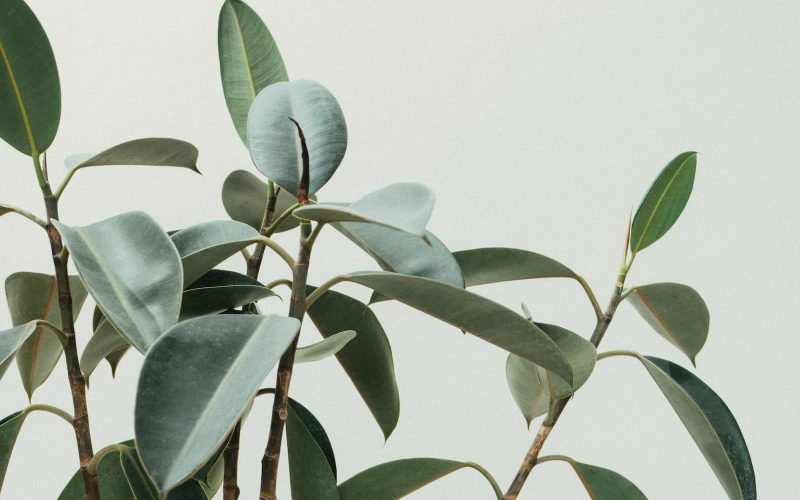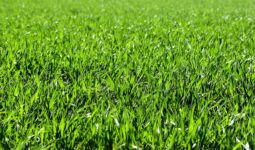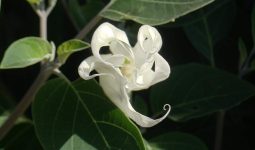If you’re in the market for some new plants and have no idea where to start, consider starting with rubber plants!
These common houseplants can be found anywhere from garden shops to grocery stores. So chances are good that you’ve seen them before.
Though there are many different types of rubber plants, each has its unique characteristics. There are some general things to know about these plants.
So that you can tell if one is right for your home or office space. Learn more about the different types of rubber plants here.
What Are Rubber Plants?
A widespread plant in tropical areas worldwide and Southeast Asian nations is the rubber tree or Ficus elastic.
The sap in this tree’s trunk gives it its particular name. It’s used to manufacture natural rubber.
Most Rubber Tree species have enormous, lush green leaves that are glossy, rubbery, and clock.
Some rubber plants have reddish-black leaves, burgundy, pink, creamy variegated, neon varied, and even those.
Rubber plants are common houseplants known for their attractive foliage and shiny, waxy leaves.
There are many different types of rubber plants that make them some unique choices for decorating your home.
Rubber plants, or Ficus elastica, are easy to grow and are a well-known variety of houseplants.
But they have some lesser-known cousins that may suit your indoor gardening needs.
Learn about the different types of rubber plants. And how you can use them to decorate any room in your home or office.
You never know when one might come in handy!
Different Types of Rubber Plants
1. Rubber Plant ‘Doescheri’
If you’re looking for a more advanced rubber plant, look no further than the Doescheri. It’s distinguished by dark green leaves veined with purple and is a slower grower than other plants. It thrives best in damp soil but can be watered daily if necessary.
Growing this plant outside will be most successful, but it will also do well inside! It’s said to survive even if the temperatures dip below 40 degrees Fahrenheit and loves humidity. So try growing it next to your bathroom sink or near a humidifier.
2. Tineke Rubber Plant
There are many different types of rubber plants out there. And one that you may not have heard about is the Tineke Rubber Plant.
In addition to being rare, this plant has a thicker leaf than the rest. And it thrives in shady areas like wooded forests.
This plant also produces tiny pink flowers during summertime and prefers less sunlight than other varieties.
Due to its love for shade, it needs to be watered frequently. Droughts are prohibited because they will droop if left without water for too long.
3. Black Prince Rubber Tree
One common form of rubber plant is the Black Prince rubber tree. This variety’s leaves have a black, leathery appearance and can reach up to three feet long.
The black-colored trunk is also often knotted and has tufts resembling corkscrew sticking out. It’s best to keep these plants away from direct sunlight to avoid drying them out. And they’ll do well in cooler climates due to their hearty constitution.
Lastly, the Lady Louise rubber tree is another less common but popular form. It features slender silvery-white leaves instead of broad ones.
The Black Prince plant has dark leaves and a slender frame rather than a wide trunk like its cousin plant.
4. Rubber Plant Ruby
Rubber plants come in various sizes and shapes. But there are three main varieties: the rubbery, broad-leafed Ruby, the needle-pointed, upright Sapphire, and the more matronly Gold.
Ruby rubber plants are well-suited to living on window sills. It features dark green leaves with a thick white coat that resists scalding. Sapphire rubber plants are smaller but make up for them with pointed needles that radiate from their slender branches.
If you prefer something a little more traditional-looking, go for Gold rubber plants with leathery leaves striped yellow and green.
5. Rubber Burgundy
It is a highly exotic plant that features glossy, thick, glossy green leaves richly variegated in light and dark hues.
The burgundy (Brugmansia) is often grown for its unusually shaped blossoms.
That feature one or two white petals extending from a large, scalloped pink-to-lavender flower head.
Many varieties grow between three and four feet tall and come with thick stems. In addition to the unusual flowers, this plant has many varied uses in society.
6. Lemon Lime Rubber
Yes, there are different types of rubber plants. Most people are probably familiar with the golden rubber plant, but those with green thumbs may not be as familiar with other varieties.
These include the Croton Stella Lisa and the Sunburst Rubber Tree. All three have different characteristics and come in their vibrant colors. For example, a golden rubber tree can grow from 10 to 15 feet tall.
It is usually grown indoors as a decorative piece rather than outside. Golden orchid-shaped leaves provide shade and give this variety an all-around tropical feel. That is welcomed in any space during the summer months.
7. Robusta Rubber
Did you know? Like most rainforest plants and trees, Robusta trees need sunlight but not too much water. An area with high humidity but not a lot of rain would be perfect!
However, it’s most often grown as a small house plant. To mimic the conditions in nature, keep it in bright, indirect light for most of the day.
It likes temperatures between 65 and 75 degrees Fahrenheit (18 and 24 degrees Celsius) during the day and 60 and 65 degrees Fahrenheit (15 and 18 degrees Celsius) at night. In addition, this type is less susceptible to pests than other types of rubber plants!
8. Green Rubber Tree
This sturdy, heavy-leafed tree produces large quantities of latex, the sap from which natural rubber is produced.
It’s often harvested commercially to make tires, bags, and even chewing gum. Plus, it boasts an iconic shade of green that lasts all year round.
The green Rubber Tree is a popular house plant. In its native Southeast Asian homeland, the sticky sap is tapped out of cuts in its bark to harvest latex, which is used in many products, such as chewing gum, car tires, bandages, and condoms.
If you’re looking for a pet-friendly plant with stunning coloration that can withstand neglect, this may be your favorite!
The green variety has leaves that stay green all year long! One of the best among the different types of rubber plants.
9. Decora Rubber
The most common among the different types of rubber plants is the decora, which is the focus of this post.
Decoras are generally upright and tend to grow best when treated like indoor plants with a south—or southeast-facing window.
A few tips for caring for a decora: don’t overwater them, be careful not to use a fertilizer that has citrus oil, keep their soil moist but not too wet, water more often in the winter than in the summer, and allow their soil to dry out a bit between watering sessions.
10. Abidjan Rubber Plan
One of the different types of rubber plants is the Abidjan rubber plant. It’s believed to be one of the hardest plants to kill.
They do not respond well to fluctuations in water levels or temperatures but will endure both without much injury.
The trunk can reach up to two meters high, and its shiny green leaves are intensely prized for food dishes. Abidjan rubber trees are primarily cultivated on farms in Côte d’Ivoire, growing wild throughout the savannah areas near Abidjan.
When tapped, these trees produce dark brown latex with a sweet taste. That has been used for generations as an alternative crop with great economic potential.
These trees have weathered famines and civil wars alike, adapting easily to each natural disaster while continuing to produce strong yields every year.
11. Variegata Rubber Tree
There are more different types of rubber plants than you think, and they come in various sizes.
The list below shows each type of plant to help you identify your plant. And the size ranges that are typical for the species.
Remember, not all rubber plants will fit neatly into a specific size range or even one type! Check to see if your specific rubber plant matches any criteria besides size.
Garraea nudicaulis, the giant bike tire rubber tree, grows from three to nine feet tall (0.9 to 2.7 meters).
In spring, this type has drooping green leaves that start getting reddish-brown spots in summer. Then it’ll die back completely by fall.
12. Creeping Fig Rubber
I like this plant because it’s always green no matter what time of year. And it thrives in low light and cold weather conditions, which are great qualities when you live somewhere. Those types of climate change occur throughout the year.
Fast-growing and vigorous, the Creeping Fig Rubber Plant is an evergreen ground cover with spreading roots and glossy leaves that can grow up to 12 inches long and 6 inches wide.
But they stay close to the ground so as not to shade other plants underneath them. They’re best planted in bright indirect light or filtered sun for part of the day and with regular watering.
13. Weeping Fig
Numerous species of plants make up the fig family, but one of the most common is the weeping fig. It’s also one of the most beautiful members with leaves that drape from drooping branches and small light green flowers.
It doesn’t grow too large and can be planted in a container or as a ground cover. They thrive in bright, indirect light and when watered properly.
This member does not require supplemental fertilizer or pruning for continued growth. It’s one of the different types of rubber plants we have around.
14. Fiddle Leaf Fig
The Fiddle Leaf Fig is not a true fig plant despite its name. Instead, it belongs to the larger family of Acanthaceae (also known as Acanthus). The plant is native to Madagascar, which lies off the southeast coast of Africa.
This tropical evergreen can reach heights of 80 feet within its natural habitat. And will only grow with rich organic soil or similar conditions in cultivation. If you need an arid landscape, this ficus should not be your first choice!
In terms of coloration, it’s difficult to say what makes for a typical Fiddle Leaf Fig. They are often striped but may also be solid green and shaped like a rectangle.
15. Banyan Fig
One of the most popular rubber plants is the banyan fig, which has fan-shaped leaves.
It’s an easy-to-maintain plant that can grow upwards and outwards in different directions at an alarming rate. Other varieties include ground rubber plants (with peeling bark), elephant foot trees, and foxtail plants.
Also, there are ice plants, moonstones, walking stick plants (more flexible than vines), and coastal redwoods. All are worth checking out if you’re looking for a new type of plant to spruce up your home.
16. Pará Rubber Tree
Native to the Amazon Rainforest, Pará rubber trees are prized for their strong sap, which was historically used to make rubber products.
But what is a Pará rubber tree? These trees’ natural habitats are in southeastern Bolivia, Brazil, and northern Bolivia near the Amazon River.
The long-lived tree only lives 50 years before it starts producing latex. But its lifespan can be prolonged if proper care is taken.
As a result, the tree was sought after not only because of its sap but also because it provides shade and fruit that can be eaten by humans and livestock alike.
When cutting down the trees to harvest their juice. They need to be boiled first before they are cooled into sheets.
17. Green Island Ficus
Green Island Ficus is a rubber plant commonly found on the West Coast. They grow in places like Southern California and Seattle and areas with moderate humidity. These plants produce lots of deep green foliage resembling large jade plants.
Typically, the tree has a tall and wide trunk with vines climbing the branches. The leaves are usually lime green, sometimes with a yellowish tinge.
These plants need medium to high humidity and do best when temperatures are below 80 degrees Fahrenheit. They’re not suitable for our climate here in Vermont!
18. Banana Leaf Fig
One of the less common rubber plant varieties, the banana leaf fig, is still a popular variety.
This unusual and stunning plant has waxy, fig-like leaves that closely resemble banana leaves. The creamy-white flowers grow in clusters and produce an intense apple fragrance.
With its lush, deep green foliage and bold colors, this plant will make a statement in any room of your home.
Banana Leaf Fig Trees thrive in well-drained, acidic soil and need good air circulation.
They require fertilizing twice a year with organic fertilizer or compost. And they should be watered when the top layer of soil feels dry to the touch.
These plants prefer bright light but not direct sunlight. So they should be placed near windows where they will get morning sun or indirect sunlight all day.
How to Care for Different Types of Rubber Plants?
Many plants require different conditions to thrive. Here are two major tips for caring for your new rubber plant:
- Put it in a warm and well-lit room -Allow the soil to dry out before watering it again.
- Watch for insect infestations or other issues that could result in rotting
Each of the different types of rubber plants has its own needs. So, you will need to do your research when picking out your new pet.
The prices range from $25 to $50, but they are worth it because they can live up to 25 years!
The ultimate decision depends on what type of atmosphere you want your new friend to live in.








